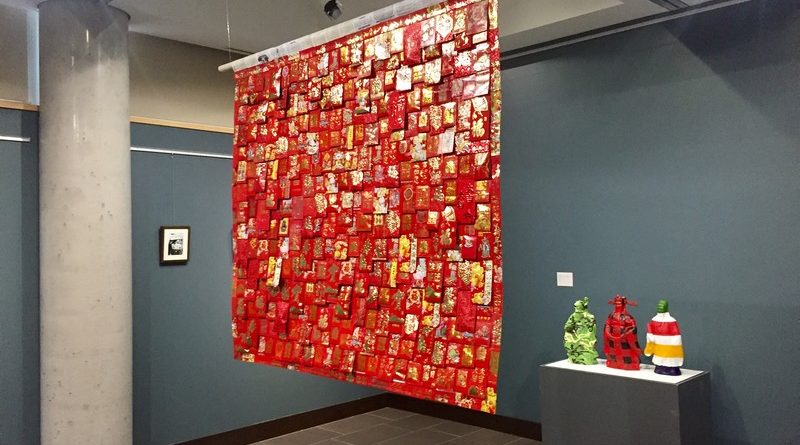Gallery Scene/Seen
Maureen Korp
Art Begat
Art and poetry at Café Nostalgica

Photo Helene Lacelle
Remember those rhymes you learned as a child? Taunting rhymes, counting rhymes: “London Bridge is falling down, falling down, …”, “One, two, buckle my shoe; three, four, close the …”. The acerbic ditties of our childhoods were originally social and political comments on the affairs of state, stuff we knew little about as children. Of course, all that was a few centuries ago in some other place. “Mary, Mary, quite contrary.”
Art Begat is the new exhibition of collaborative work by Peter Evanchuck and Hélène Lacelle at Café Nostalgica, University of Ottawa. The exhibition includes examples of the artists’ ironic use of photography, text, painting, and drawing. Their work may well remind you of those contradictory rhymes and events from childhood, that you have set aside.
The subject matter of the exhibition is one contrasting the child’s point of view with the seemingly sensible world of the adult. The child has permission to look out for the spider, to pay attention to the owl. It is the adult who explains why this is so. Yet neither adult nor child knows what may be, or really is, to be found around the next corner. Marvelous Realism Canada, a photocollage by Evanchuck and Lacelle, for example, is an elaborated scene of children swimming in a canal somewhere. Is swimming here permitted? Where’s the lifeguard?
Art Begat includes two presentations of Peter Evanchuck’s ironic verses, Once a Spider and The Hoo Who and Why Owl. Each verse shown is hand-drawn, illustrated and framed in the manner of a contemporary, two-part illuminated manuscript.
Both texts begin quietly enough; but both conclude with a quick metaphorical whack upside the head. For example, The Hoo Who and Why Owl begins, “Polliwogs into Frogs, wiggle in Bogs, eating like Hogs.” A few lines later, “Owl sees, hears, then fears-all; a fright that ruins his night.”
Agreed, a hooting owl might ruin anyone’s sleep. There is a moral to the tale. Evanchuck tells us what to do: “When up the Tree of Life pondering Hoo, Who and Why, put in the Ear Plugs.”
Evanchuck’s verse entitled Once a Spider similarly concludes with an apt moral, “Life isn’t fair when U live on dare aware that U eat Ur pals. It gets lonely.”
The drawing and calligraphy for both verse presentations are by Hélène Lacelle.
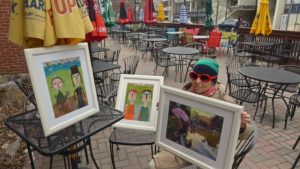
Photo Peter Evanchuck
Throughout the exhibition, there is a reaching out to other times and places in the work shown. A photocollage by Hélène Lacelle, entitled Un jour à Ho Chi Minh City, depicts a street lively with motorcycles and cars. Lacelle’s Sisters on the other hand, is a simple gouache painting of two standing figures. She has painted it in the style of a folk artist. Gouache, a water-based paint, is also known as poster paint: the same medium used centuries ago to illustrate medieval manuscripts. The eye of the artist is a constant over time.
Reviews of the artists’ work from other recent exhibitions are displayed.
The exhibition continues until June 30. The work is quite modestly priced, frames included, in the range of $75 to $325. Café Nostalgica is located in the midst of the University of Ottawa’s Sandy Hill campus. Excellent food and craft beers aplenty are available. Café policy emphasizes the use of biodegradable materials, fair-trade, locally sourced, organic foods. Open Mondays-Fridays, 11 to 11, the café is owned and operated by the U of O Graduate Students’ association. The café welcomes all, and has become a favoured exhibition site for the work of Peter Evanchuck and Hélène Lacelle.
Art Begat: Art and poetry
Continuing until June 30, at
Café Nostalgica
601 Cumberland St.
Ottawa, Ontario
Alejandro Salgado Cendales and Don Kwan
Weaving the web
The Chinese Experience in Canada
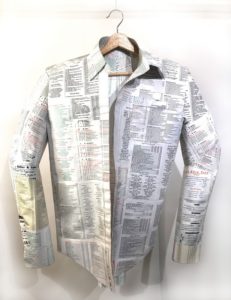
Anyone got a hankering for Chinese? A yen for Szechuan? Cantonese? Is that place over there any good? How often have you heard those questions? More than once, no doubt. With a bit of luck, moments later, you are settled into place, pondering the menu and the merits of General Tao’s Chicken or Buddha’s Delight, egg rolls, pot stickers, good noodle soup. Very likely, your favourite Chinese restaurant is family owned. Have you ever wondered how it was this restaurant came to be here in Ottawa, or anywhere at all in Canada?
The new exhibition at Gallery 112 addresses some of these questions. Weaving the Web: the Chinese Experience in Canada is an installation by Alejandro Salgado Cendales and Don Kwan.
Walking into the gallery, the visitor’s eye goes first to Invisible Identities, a suspended sculpture by Don Kwan. Three men’s garments, two vests and a shirt, hang aloft. Each is carefully tailored from materials fabricated of Chinese restaurant menus, bedecked with photographs of happy groups of people gnoshing away at their meals. You may recognize a face or two among the crowds. Your own? Perhaps. Pierre Eliot Trudeau is here, too.
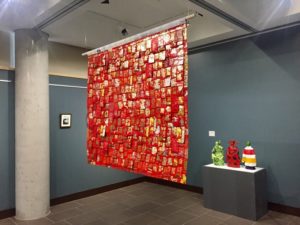
Good Luck Quilt, by Don Kwan hangs nearby. The quilt, a large paper tapestry, is made of 397 individually filled Lai See, the red envelopes usually filled with money as offerings for good luck, good fortune. Are these 397 envelopes filled with money!!? No. Even better. They are filled with knowledge.
For more than two years, Kwan asked people to write, on small slips of paper, what they themselves knew in their own lives to be a sign of good fortune. One person wrote, “A day with no pain.” Another wrote, “Friends.” As people learned of Kwan’s project, some donated their own lucky tokens for the work – including, one miniature toy brontosaurus.
Don Kwan photographed all before fastening each into an envelope for the tapestry. Twelve photographs are displayed on one wall of the gallery. They provide a sense of the blessings within the work of the quilt.
Along two other walls of the gallery are intricately constructed digital collages by Alejandro Salgado Cendales. Each composition is backed by Cendales’ research into historical events of injustice throughout the story of Chinese-Canadian life. How was the Head Tax applied? Who got the money? How was the railway built? In Gold Mountain (Gum Shan), for example, we see patterns of people: all the same, all ghosts. The composition alludes to the relocation of Chinese workers to the Fraser Valley in the mid-nineteenth century.
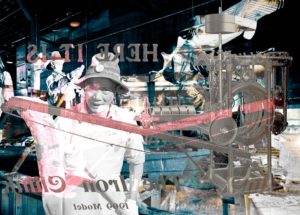
Racist laws specific to the Chinese were passed throughout much of the Nineteenth and Twentieth Centuries in Canada. Work restrictions were only part of those laws. Cendales makes this particularly clear in one brutal composition. Through the window of an industrial shop, we can see a young man and some large pieces of machinery. The writing on the window declares to the world outside, “Here it is. 1909 Model. The Iron Chink.”
Yes. That is the foul name given to a piece of machinery invented and marketed as such in Canada. Each could do the work of 50 people in the fish canneries.
Some of these matters are further discussed in two films Alejandro Salgado Cendales made to accompany the exhibition. Sam Gee, one of the artist’s key sources, tells his story well – from the days of hearing “chin, chin, chow, Chinaman” on Ottawa’s streets to the lack of even a symbolic redress from the Canadian government. Sam Gee is 93.
Alejandro Salgado Cendales immigrated to Canada two years ago. Don Kwan’s family has been in Canada for many generations.

Weaving the web: The Chinese experience in Canada
Continuing to July 6, at
Gallery 112, City of Ottawa Central Archives, James K Bartleman Centre, 100 Tallwood Dr., off Woodroffe Ave.
Free: Tues. to Fri., 9 a.m. to 4 p.m.; Sat., 10 a.m. to 5 p.m.
Other exhibitions of interest
Canadiana
Deborah Arnold, Barbara Gamble, Karen Haines, George Horan
Sivarulrasa Gallery
34 Mill St., Almonte
Open daily to the public. Free
The show runs until June 30.
Places, paths, and pauses
Marlene Creates
at Carleton University Art Gallery until August 25
On Location: Human Interventions in the Landscape
Lorraine Gilbert, Stephen Livick, John Pfahl
at Carleton University Art Gallery until August 25
St. Patrick’s Building, 1125 Colonel By Dr., Ottawa
Open to the public Tuesday to Sunday. Free
Summer Camp
SPAO Centre: School for Photographic Arts
77 Pamilla St., Ottawa until July 1
Open Wednesday to Saturday, noon to 5 pm, and by appointment. Free.
